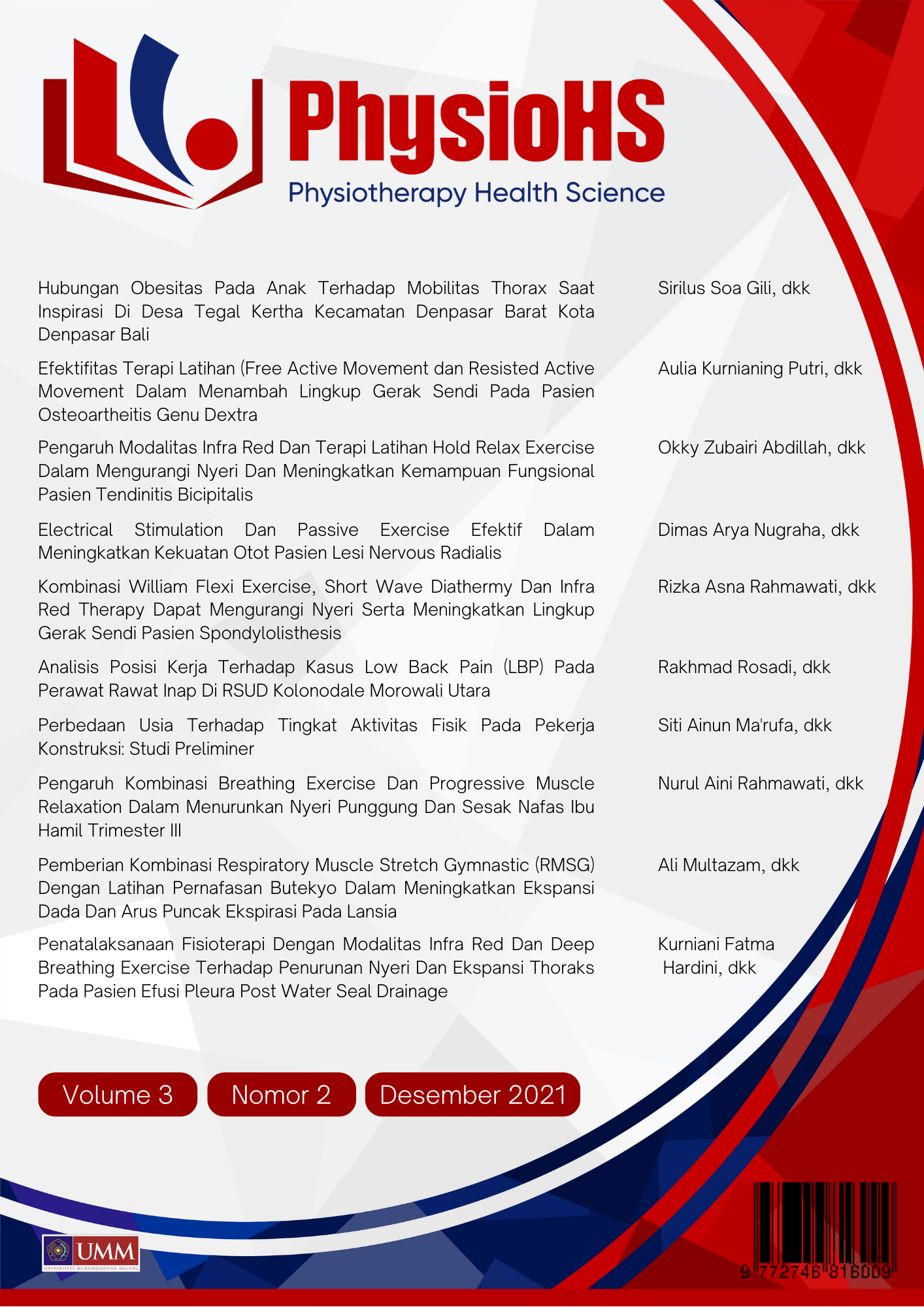Electrical Stimulation Dan Passive Exercise Efektif Dalam Meningkatkan Kekuatan Otot Pasien Lesi Nervus Radialis
DOI:
https://doi.org/10.22219/physiohs.v3i2.18969Keywords:
Lesi Nervus Radialis, Electrical Stimulation, Passive Exercise, Kekuatan OtotAbstract
Lesi Nervus Radialis merupakan suatu injury berupa keadaan yang abnormal pada lengan, dimana otot-otot yang disarafi oleh plexus brachialis mengalami kelumpuhan. Pada gangguan lesi plexus brachialis dapat terjadi atrofi yang disebabkan karena lengan inaktif bergerak. Manifestasi dari Lesi Nervus Radialis salah satunya adalah Drop Hand. Metode yang digunakan pada kasus ini yaitu Modalitas Electrical Stimulation dan Passive Exercise yang efektif dalam meningkatkan kekuatan otot pada pasien lesi nervus radialis. Setelah dilakukan terapi selama enam kali didapatkan hasil perubahan meningkatnya kekuatan otot pada gerakan Palmar Flexi T0 : 5 menjadi T6 : 5, Dorsal Flexi T0 : 1 menjadi T6 : 3, Radial Deviasi T0 : 2 menjadi T6 : 3, dan Ulnar Deviasi T0 : 4 menjadi T6 : 5.
Downloads
References
Amin, A. A., Amanati, S., Purnomo, D., & Putra, A. P. (2018). ‘Pengaruh Infra Red, Electrical Stimulation dan Terapi Latihan pada Drop Hand et causa Post op Fraktur Humerus’. Jurnal Fisioterapi dan Rehabilitasi Vol.2, No.1.
Bergquist, Clair, & Collins. (2011). ‘Motor Unit Recruitment When Neuromuscular Electrical Stimulation is Applied Over a Nerve Trunk Compared With a Muscle’.
Brunners, & Suddart. (2010). ‘Keperawatan Medikal Bedah’. Jakarta: EGC.
Millan, M. I. (2012). ‘Tyldesley & Grieve's Muscle, Nerves and Movement in Human Occupation’. Edisi: 4 wiley black well.
Kisner, & Colby. (2018). ‘Pengaruh Infra Red, Electrical Stimulation dan Terapi Latihan pada Drop Hand et causa Post operasi Fraktur Humerus’. Jurnal Fisioterapi dan Rehabilitasi Vol.2, No.1.
Korompilias, A. (2013). ‘Approach To Radial Nerve Palsy Caused By Humerus Shaft Fracture’. Is Primary Exploration Neccesary Injury, Int. J. Care Injured.
Kwon & Choi. (2013). ‘The effect of repatitive passive and active movements on propioception ability in forearm supination’.
Satoto, & Darto. (2013). ‘Saraf Perifer Masalah dan Penanganannya’. Jakarta: Salemba Medika.
Schuhfried, O., & Crevenna, R. (2012). ‘Non Invansive Neuromuscular Electrical Stimulation in Patient With Central Nervous System Lesion’. Journal Rehabilitation Med.
Suratun. (2010). ‘Klien Dengan Gangguan Sistem Muskuloskeletal’. Jakarta: EGC.
Wahyono & Budi. (2016). ‘Penatalaksanaan Fisioterapi Pada Keterbatasan Lingkup Gerak Sendi Bahu Akibat Post ORIF Fraktur Shaft Humerus Dextra di Kelurahan Alalak Utara Banjarmasin’. Jurnal Kajian Ilmiah Kesehatan dan Teknologi.
Waschke, J., & Paulsen, F. (2011). ‘Sobotta Atlas of Human Anatomy’. Muchen: Elsevier Urban & Fischer.
Downloads
Published
How to Cite
Issue
Section
License
Copyright (c) 2021 Physiotherapy Health Science (PhysioHS)

This work is licensed under a Creative Commons Attribution-ShareAlike 4.0 International License.
Authors who publish with Physiotherapy Health Science (PhysioHS) agree to the following terms:
- For all articles published in Physiotherapy Health Science (PhysioHS), copyright is retained by the authors. Authors give permission to the publisher to announce the work with conditions. When the manuscript is accepted for publication, the authors agree to automatic transfer of the publishing right to the publisher.
- Authors retain copyright and grant the journal right of first publication with the work simultaneously licensed under a Creative Commons Attribution-ShareAlike 4.0 International License that allows others to share the work with an acknowledgement of the work's authorship and initial publication in this journal.
- Authors are able to enter into separate, additional contractual arrangements for the non-exclusive distribution of the journal's published version of the work (e.g., post it to an institutional repository or publish it in a book), with an acknowledgement of its initial publication in this journal.
- Authors are permitted and encouraged to post their work online (e.g., in institutional repositories or on their website) prior to and during the submission process, as it can lead to productive exchanges, as well as earlier and greater citation of published work (See The Effect of Open Access).
This work is licensed under a Creative Commons Attribution-ShareAlike 4.0 International License.





















